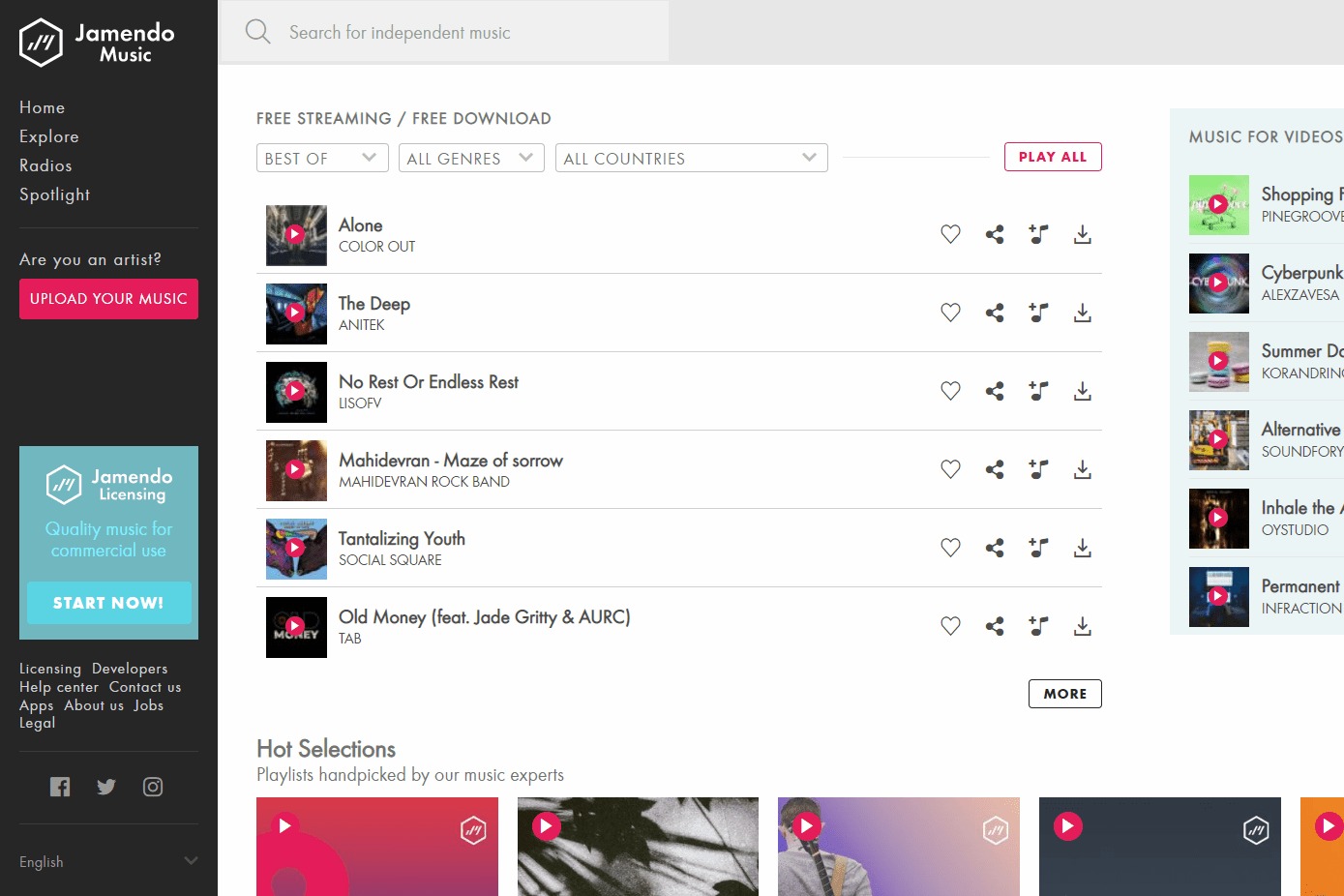Home>Events & Info>Podcast>How Can I Start A Podcast For Free


Podcast
How Can I Start A Podcast For Free
Modified: January 22, 2024
Start your own podcast today for free with our easy-to-use platform. Learn all the steps to launch and grow your podcast, from recording to distribution, with our comprehensive guide.
(Many of the links in this article redirect to a specific reviewed product. Your purchase of these products through affiliate links helps to generate commission for AudioLover.com, at no extra cost. Learn more)
Table of Contents
- Introduction
- Finding a Free Podcast Hosting Platform
- Choosing a Podcast Name and Topic
- Planning and Scripting Your Podcast Episodes
- Selecting the Right Equipment and Software
- Recording and Editing Your Podcast
- Creating Intro and Outro Music or Sound Effects
- Designing a Podcast Cover Art
- Submitting Your Podcast to Directories
- Promoting and Marketing Your Podcast
- Monetizing Your Podcast
- Conclusion
Introduction
Podcasting has become a popular and powerful medium for sharing stories, insights, and knowledge with the world. Whether you’re a passionate storyteller, expert in a particular field, or simply looking to connect with like-minded individuals, starting a podcast can be an enriching and rewarding experience.
However, many people assume that starting a podcast requires a significant financial investment. The truth is, there are plenty of free podcasting options available that allow you to get started without breaking the bank. In this article, we’ll explore how to start a podcast for free, including finding a hosting platform, planning your content, selecting equipment, recording and editing your episodes, creating engaging cover art, submitting to directories, and promoting your podcast.
With the rise of podcast hosting platforms that offer free plans, it has never been easier to bring your podcasting dreams to life. These platforms provide the necessary tools to upload, store, and distribute your podcast episodes to popular directories such as Apple Podcasts, Spotify, and Google Podcasts.
Before we dive into the technical details, it’s essential to have a clear understanding of what your podcast will be about. Ask yourself: What topics am I passionate about? What unique perspective can I bring to the table? Who is my target audience? Once you have a solid idea in mind, you can move forward to the next steps.
As you embark on your podcasting journey, keep in mind that preparation is key. Investing time in planning, scripting, and organizing your episodes will help you deliver high-quality content that captivates your audience.
Now, let’s dive into the specifics of how to start a podcast for free, from finding a hosting platform to promoting and monetizing your show. By the end of this article, you’ll have all the knowledge and tools you need to share your voice and make an impact in the exciting world of podcasting.
Finding a Free Podcast Hosting Platform
When it comes to starting a podcast, finding the right hosting platform is crucial. A podcast hosting platform is where your audio files are stored and distributed to podcast directories. Luckily, there are several free options available that offer everything you need to get started.
One popular free podcast hosting platform is Anchor. Anchor provides an all-in-one solution for podcasters, offering free hosting, distribution to all major podcast platforms, and even monetization options. With its user-friendly interface and comprehensive features, Anchor has become a go-to choice for many podcasters.
Another free hosting platform is Podbean. It offers a free plan with limited storage space and bandwidth, making it ideal for beginners or podcasters with a smaller audience. Podbean also provides simple podcast creation tools, easy distribution, and monetization options.
SoundCloud is another platform that offers a free plan for podcasters. While primarily known for hosting music, SoundCloud allows you to upload and distribute your podcast episodes. With its large community of users, SoundCloud can help you reach a wider audience.
Aside from these specific platforms, some podcast hosting providers offer free plans with certain limitations. Libsyn, for example, has a free plan with restricted monthly upload limits. This can be a good option if you’re starting out and don’t have a large backlog of episodes.
When choosing a free podcast hosting platform, consider factors such as storage space, bandwidth limitations, ease of use, distribution to podcast directories, and monetization options. Research each platform’s features and decide which one aligns best with your podcasting goals and needs.
It’s worth noting that while these platforms offer free hosting, they may also provide paid plans with additional features and benefits. If you find that your podcast grows and you require more advanced tools and capabilities, you can consider upgrading to a paid plan in the future.
Once you’ve chosen a hosting platform, sign up for an account and familiarize yourself with the interface. Most hosting platforms provide tutorials and resources to help you make the most of their features.
With a free hosting platform in place, you’re one step closer to launching your podcast and sharing your unique voice with the world.
Choosing a Podcast Name and Topic
One of the first and most important steps in starting a podcast is choosing a compelling name and defining your podcast’s topic. Your podcast name should be catchy, memorable, and reflective of the content you’ll be sharing. Here are some tips to help you choose the perfect podcast name:
- Consider your target audience: Think about who you want to reach with your podcast. What interests and topics are they likely to be interested in? Tailor your podcast name to appeal to your target audience.
- Be descriptive: Your podcast name should give listeners a clear idea of what to expect. Use keywords that reflect the main theme or subject of your podcast.
- Keep it concise: Aim for a short and snappy podcast name that is easy to remember. Avoid long and complicated names that might be difficult for listeners to recall.
- Brainstorm and research: Spend some time brainstorming different ideas for your podcast name. Write down keywords, phrases, and concepts that relate to your podcast’s topic. Once you have a list, research to ensure that your chosen name is not already in use by another podcast.
- Test it out: Once you have a few potential names, try saying them out loud. How do they sound? How do they feel? Choose a name that resonates with you and feels right for your podcast.
Once you have a name, it’s time to define your podcast’s topic. Consider your passion, expertise, and what you want to share with your audience. Ask yourself:
- What subjects or topics am I knowledgeable about?
- What am I passionate about?
- What value can I provide to listeners?
Your podcast topic should align with your interests and expertise while also being relevant and engaging for your target audience. It’s essential to have a clear focus and direction for your podcast to attract and retain listeners.
Consider niching down your topic to stand out in a crowded podcasting landscape. Instead of a broad topic like “fitness,” you could focus on “weightlifting for beginners” or “yoga for stress relief.” By narrowing your focus, you can attract a specific audience who are passionate about that particular niche.
Once you have chosen a podcast name and topic, conduct some research to see if there are other podcasts covering similar subjects. Listen to existing podcasts to get inspiration and to identify opportunities to differentiate yourself.
Remember, your podcast name and topic should reflect who you are and what you want to share with the world. By choosing a compelling name and defining a focused topic, you’ll be well on your way to creating a podcast that stands out and resonates with listeners.
Planning and Scripting Your Podcast Episodes
Planning and scripting your podcast episodes is a crucial step in creating high-quality content that engages and captivates your audience. While some podcasts are more conversational and unscripted, having a structured outline or script can help you stay on track and deliver your message effectively. Here’s how to plan and script your podcast episodes:
- Outline the main points: Start by outlining the main points or topics you want to cover in your episode. This will serve as a roadmap for your conversation or narration.
- Research and gather information: If your podcast involves discussing or sharing information on a specific topic, conduct thorough research to gather relevant and accurate information. This will ensure that your content is informative and valuable to your listeners.
- Create a logical flow: Arrange your main points in a logical and coherent order. Think about the progression of your episode and how each point connects to the next. This will help guide your listeners through the episode smoothly.
- Add subheadings or sections: Break down your main points into subheadings or sections. This will help you stay organized and make it easier for listeners to follow along.
- Consider storytelling elements: If your podcast involves storytelling, think about how you can incorporate narrative elements into your script. This can include anecdotes, personal experiences, or case studies that add depth and engagement to your episodes.
- Write a script or create bullet points: Depending on your preferred style, you can either write a full script or create bullet points for each section or subheading. A script provides a more detailed and structured approach, while bullet points offer flexibility for a more conversational tone.
- Practice and refine: Once you have your script or bullet points, practice delivering your episode. Pay attention to your pacing, tone, and overall delivery. Refine and make adjustments as necessary to enhance the flow and clarity of your content.
It’s important to note that while scripting can provide structure, it’s also essential to maintain a natural and authentic delivery. Avoid sounding robotic or rehearsed; instead, aim for a conversational tone that resonates with your audience.
Remember that not all podcasts require a strict script. If you prefer a more spontaneous and unscripted approach, create a detailed outline with key points to help you stay focused during the episode.
Lastly, be open to improvisation and allow for spontaneity within your scripted or outlined framework. Your listeners will appreciate the authenticity and genuine moments that arise from unscripted conversations.
By planning and scripting your podcast episodes, you’ll be well-prepared to deliver engaging and informative content that keeps your audience coming back for more.
Selecting the Right Equipment and Software
Choosing the right equipment and software is crucial to ensure the quality of your podcast episodes. While it’s possible to start a podcast on a budget, investing in reliable equipment can significantly improve the overall sound and production value of your show. Here are some essential considerations when selecting podcasting equipment and software:
1. Microphone:
A good quality microphone is the most important piece of equipment for podcasting. USB microphones are a popular choice as they offer simplicity and ease of use. Some popular options include the Blue Yeti, Audio-Technica ATR2100x-USB, and Samson Q2U. For more professional setups, XLR microphones paired with an audio interface provide even better sound quality. Popular XLR microphones include the Shure SM58 and Rode Procaster.
2. Headphones:
Investing in a pair of closed-back headphones is essential for monitoring your audio during recording and editing. Closed-back headphones isolate external noise, allowing you to hear your audio with greater clarity. Some popular options include the Audio-Technica ATH-M50x and Sony MDR-7506.
3. Pop Filter and Shock Mount:
A pop filter helps alleviate plosive sounds (“p” and “b” sounds) that can cause distortion, while a shock mount reduces vibrations and handling noise. These accessories can greatly improve the audio quality of your recordings. Look for universal pop filters and shock mounts that are compatible with your microphone.
4. Recording and Editing Software:
For recording your episodes, Audacity is a free and popular choice among podcasters. It’s a user-friendly software that offers basic editing capabilities. If you prefer more advanced features, Adobe Audition and GarageBand are widely used options. These software programs allow you to edit and enhance your audio recordings, remove background noise, and add effects.
5. Acoustic Treatment:
Consider your recording environment and invest in some basic acoustic treatment to reduce echo and unwanted room noise. This can include using foam panels or a portable vocal booth to create a more controlled recording space.
6. Remote Recording:
If you plan to have guests on your podcast who cannot be physically present, consider using remote recording software such as Zencastr or SquadCast. These platforms allow you to record high-quality audio from multiple participants in separate locations, making remote interviews and collaborations seamless.
When selecting your podcasting equipment and software, consider your budget, the level of quality you aim to achieve, and your specific podcasting needs. It’s important to strike a balance between affordability and quality to ensure a professional and engaging listening experience.
Once you have your equipment and software in place, take the time to familiarize yourself with their features and settings. Experiment with different microphone positions, recording techniques, and editing tools to find the optimal setup for your podcast.
Remember, the right equipment and software are essential tools that can elevate the production value of your podcast and make a lasting impression on your listeners.
Recording and Editing Your Podcast
Recording and editing your podcast is where the magic happens. This is the stage where you bring your ideas to life and shape your episodes into polished, professional content. Here are the key steps to successfully record and edit your podcast:
1. Find a quiet and controlled recording environment:
Choose a location with minimal background noise and distractions. Ideally, a room with soft furnishings or a closet filled with clothes can help absorb echo and improve the sound quality of your recordings. Consider using a microphone isolation shield or portable vocal booth to further enhance the acoustics.
2. Set up your equipment and test the audio:
Connect your microphone to your computer or audio interface and open your recording software. Place the microphone at an appropriate distance from your mouth and adjust the input gain level to avoid clipping or distortion. Conduct a test recording and listen back to ensure the sound levels are balanced and clear.
3. Structure your episodes and hit record:
Based on your podcast outline or script, start recording your episode. Speak clearly and at a consistent volume, ensuring that you maintain a natural and engaging delivery throughout. If you make a mistake, don’t worry – pause briefly, then restate the section and continue.
4. Edit out mistakes and polish your audio:
Once you have finished recording, it’s time to edit your episode. Use your chosen editing software to remove any mistakes, long pauses, or irrelevant tangents. Trim out any background noise or unwanted sounds and ensure smooth transitions between sections or segments.
5. Enhance the audio quality:
Apply audio effects and filters to enhance the overall sound quality of your podcast. These can include noise reduction, equalization to adjust frequencies, compression to even out volume levels, and normalization to ensure consistent audio levels throughout the episode. Experiment with these effects to find the right balance for your podcast.
6. Add music and sound effects:
To make your podcast more engaging, consider adding intro and outro music, as well as sound effects to enhance specific moments or transitions. Ensure that you have the necessary licenses for any copyrighted material you use or consider using royalty-free music and sound effects libraries.
7. Mix and export your final episode:
Once you are satisfied with your edits, mix all the audio elements together, adjusting the levels to achieve a coherent and balanced final product. Export the episode in a suitable audio format, such as MP3 or WAV, ensuring that the file size is optimized for web streaming and sharing.
Remember to save your raw recordings and project files for future reference or re-editing if needed. It’s a good practice to create backups of your edited episodes to prevent any data loss.
As you gain experience, you’ll become more efficient in your recording and editing process. Continuously strive to improve the quality of your sound and the overall flow of your episodes. Your listeners will appreciate the attention to detail and the professionalism that comes with a well-edited podcast.
Creating Intro and Outro Music or Sound Effects
Creating an engaging and memorable podcast often involves incorporating intro and outro music, as well as sound effects. These audio elements help set the tone, establish your brand, and create a cohesive listening experience for your audience. Here are some tips for creating your own intro and outro music or sound effects:
1. Define your podcast’s style and mood:
Think about the overall feel and vibe of your podcast. Is it upbeat and energetic, or calm and introspective? Consider your target audience and the tone that best aligns with your content. This will guide your creative process and help you create music or sound effects that resonate with your listeners.
2. Choose the right instruments and sounds:
Select instruments or sounds that convey the desired mood and complement your podcast’s theme. You can use virtual instruments or samples if you don’t play any instruments yourself. Experiment with different combinations until you find a sound that captures the essence of your podcast.
3. Create a catchy melody or motif:
Aim for a memorable and catchy melody or motif that will stick with your listeners. This can be a simple musical phrase or a brief sound effect that represents your podcast. Consider incorporating elements that reflect your podcast’s theme or use musical techniques to evoke specific emotions.
4. Keep it concise:
Intro and outro music or sound effects should be relatively short to avoid overshadowing your main content. Aim for a duration of 15-30 seconds, providing enough time to set the mood and introduce your podcast, but without becoming too lengthy or repetitive.
5. Consider professional assistance:
If you don’t have musical experience or feel unsure about your creative skills, consider seeking help from a professional music composer or sound designer. You can find freelance musicians or sound engineers who specialize in creating custom audio elements for podcasts.
6. Use royalty-free music or sound libraries:
If you prefer to use pre-existing music or sound effects, make sure to follow copyright guidelines and use royalty-free resources. There are plenty of websites and libraries available that offer a wide range of music and sound effects for podcast use. Just ensure that you comply with the licensing terms and properly attribute any necessary credits.
7. Test and refine:
Once you have created your intro and outro music or sound effects, test how they sound in the context of your podcast. Listen to them within the full episode to ensure they flow seamlessly and complement the overall content. Make any necessary adjustments or refinements to achieve audio consistency and enhance the listening experience.
Remember, the goal of your intro and outro music or sound effects is to create a memorable and professional impression on your listeners. By investing time and effort into crafting these elements, you’ll establish a distinct identity for your podcast and make it more engaging and enjoyable for your audience.
Designing a Podcast Cover Art
Your podcast cover art is the first visual representation of your show that potential listeners will see. It serves as a crucial element in attracting attention, conveying your podcast’s theme, and setting expectations for your audience. When designing your podcast cover art, consider the following tips:
1. Reflect your podcast’s content:
Choose imagery, colors, and typography that align with the theme and tone of your podcast. The cover art should give potential listeners a glimpse into what your show is about and create intrigue. Consider using visuals that capture the essence of your podcast’s topic or incorporate elements that represent your unique perspective.
2. Keep it simple and eye-catching:
Avoid cluttering your cover art with too much text or intricate designs. Focus on a clean and visually pleasing composition that stands out in podcast directories. Utilize bold, high-contrast colors and fonts that are easy to read, even at smaller sizes.
3. Choose the right dimensions and format:
Podcast platforms often have specific requirements for cover art dimensions. It’s essential to create your artwork in the recommended size, typically a square format ranging from 1400×1400 to 3000×3000 pixels. Aim for a high-resolution image (at least 72 DPI) to ensure a crisp appearance on various platforms.
4. Consider branding and consistency:
Your cover art should be visually consistent with your overall brand identity. If you have a logo or established color palette for your podcast, incorporate those elements into the design. Consistency across your branding materials helps establish recognition and builds a cohesive visual identity for your show.
5. Incorporate text effectively:
Your podcast’s title and subtitle (if applicable) should be legible and clearly visible on your cover art. Choose a font that complements your overall design and ensures readability. Experiment with placement, size, and typography to find the best balance between visual appeal and clarity.
6. Seek professional help if needed:
If you lack design skills or prefer to entrust the task to a professional, consider hiring a graphic designer or using freelance design services. Many designers specialize in creating podcast cover art and can help bring your vision to life. Websites like Fiverr and Upwork offer a wide range of talented designers with various pricing options.
7. Get feedback:
Before finalizing your cover art, gather feedback from trusted friends or fellow podcasters. They can provide valuable insights and help you identify any areas for improvement. Remember, constructive criticism can be instrumental in refining the visual impact of your cover art.
Ultimately, your podcast cover art should be visually appealing, communicate the essence of your show, and entice potential listeners to click and explore further. It’s a visual representation of your podcast’s brand, so invest time and effort into creating cover art that captures attention and accurately represents your content.
Submitting Your Podcast to Directories
Once you’ve created your podcast episodes and designed your cover art, it’s time to get your podcast out into the world by submitting it to podcast directories. Podcast directories are platforms that host and distribute podcasts, making them easily accessible to listeners on various devices and platforms. Here’s how to submit your podcast to directories:
1. Apple Podcasts (formerly iTunes):
Apple Podcasts is one of the most popular podcast directories. To submit your podcast, you’ll need an Apple ID and access to Apple’s Podcasts Connect portal. Provide your podcast’s RSS feed, artwork, title, and other necessary details. Apple will review your submission before listing your podcast.
2. Spotify:
To submit your podcast to Spotify, you’ll need an account with Spotify for Podcasters. Navigate to the Spotify for Podcasters dashboard, where you can submit your podcast’s RSS feed, artwork, and other information. Spotify reviews submissions and typically lists accepted podcasts within a few days.
3. Google Podcasts:
Google Podcasts is another major directory. Submitting your podcast to Google Podcasts is as simple as publishing your episodes on your podcast hosting platform. Google automatically indexes and displays podcasts based on their RSS feeds, making them searchable on Google Podcasts.
4. Other podcast directories:
In addition to the major directories mentioned above, there are several others you can submit your podcast to, such as Stitcher, TuneIn, iHeartRadio, and Pocket Casts. Each platform has its submission process, so visit their respective websites and follow the instructions for getting your podcast listed.
5. Verify and optimize:
After submitting your podcast to directories, it’s essential to verify that your podcast appears correctly. Check that your episodes play correctly, your cover art displays properly, and all the information is accurate. Additionally, optimize your podcast’s metadata, including your podcast title, description, and episode titles, for search engine optimization (SEO).
6. Update regularly:
Once your podcast is listed on directories, it’s important to update it regularly with new episodes. This helps to maintain engagement with your audience and improve your podcast’s visibility. Most podcast directories automatically update your listings when new episodes are published via your RSS feed.
7. Promote your podcast:
While submitting your podcast to directories is crucial, it’s just the first step. To drive listenership, actively promote your podcast through various channels. Utilize social media platforms, your website or blog, email newsletters, and collaborations with other podcasters or influencers in your niche.
Remember, it may take some time for your podcast to appear on directories after submission. Some directories have review processes and may require manual approval. Be patient and continue focusing on creating valuable content while actively engaging with your audience.
Submitting your podcast to directories is a vital step in expanding your reach and attracting listeners. By ensuring your podcast is listed on major platforms, you increase your chances of gaining new subscribers and growing your podcasting success.
Promoting and Marketing Your Podcast
Once your podcast is live and listed on directories, it’s time to focus on promoting and marketing it to attract listeners and grow your audience. Effective promotion and marketing strategies can help you reach a wider audience and increase engagement with your podcast. Here are some key steps to promote and market your podcast:
1. Leverage social media:
Utilize social media platforms such as Twitter, Instagram, Facebook, and LinkedIn to promote your podcast. Create engaging posts, share episode highlights, behind-the-scenes content, and interact with your audience. Encourage listeners to share your podcast with their networks.
2. Create a website or blog:
Having a dedicated website or blog for your podcast is a valuable asset. It allows you to showcase your episodes, provide additional resources, and engage with your audience. Optimize your website or blog for search engines to improve your podcast’s discoverability.
3. Guest appearances and collaborations:
Look for opportunities to be a guest on other podcasts or invite guests from your niche onto your own show. Collaborating with other podcasters or influencers can introduce your podcast to new audiences and help you connect with industry experts.
4. Cross-promotion:
Consider partnering with other podcasters to cross-promote each other’s shows. Share episode promos or participate in joint episodes to tap into each other’s listenership and expand your reach organically.
5. Engage with your audience:
Reply to comments and messages from your listeners, and encourage them to leave reviews or ratings on podcast directories. Engaging with your audience creates a sense of community and cultivates loyal fans who are more likely to promote your podcast to others.
6. Utilize email marketing:
Build an email list and send regular newsletters to your subscribers. Share updates, new episode releases, exclusive content, and any other relevant information to keep your audience engaged and connected with your podcast.
7. Run promotions and giveaways:
Consider running promotional campaigns or giveaways to encourage listener engagement and attract new followers. Offer exclusive content, merchandise, or other incentives to incentivize listeners to become active supporters and advocates of your podcast.
8. Harness the power of SEO:
Optimize your podcast titles, episode descriptions, and show notes for search engine optimization (SEO). Use relevant keywords, descriptive titles, and well-crafted descriptions to improve your podcast’s visibility in search engines and podcast directories.
9. Seek media coverage:
Reach out to relevant media outlets, bloggers, or journalists to share your podcast story. Pitch your podcast as a unique and valuable resource to their audience, offering insights into your expertise or a captivating narrative that aligns with their interests.
10. Analyze and adjust:
Regularly review podcast analytics, such as listener demographics, episode performance, and engagement metrics. Use this data to make informed decisions about your podcast’s content and marketing strategies. Adapt and iterate based on what works best for your audience.
Remember, effective promotion and marketing require consistent effort and creativity. Experiment with different strategies, track your results, and refine your approach based on audience feedback and engagement. Building and growing your podcast audience takes time and persistence, so be patient and stay committed to providing valuable content to your listeners.
Monetizing Your Podcast
Monetizing your podcast can be a rewarding way to generate income from your hard work and passion. While it may take time and effort to build an audience and establish credibility, there are several strategies you can implement to monetize your podcast. Here are some popular methods:
1. Sponsorships and advertisements:
One common way to monetize a podcast is through sponsorships and advertisements. As your podcast grows in popularity, you can approach relevant brands or agencies for potential sponsorship opportunities. Offer ad spots or product endorsements during your episodes in exchange for monetary compensation or free products/services.
2. Affiliate marketing:
By becoming an affiliate, you can earn commissions by promoting products or services within your podcast episodes or show notes. Sign up for affiliate programs related to your podcast’s niche and share unique promo codes or affiliate links. When your audience makes a purchase through those links, you receive a commission.
3. Premium content or subscriptions:
Create exclusive content or bonus episodes that are available only to paid subscribers. Offer additional value, behind-the-scenes content, or deep dives into specific topics. Platforms like Patreon or Supercast can assist in setting up membership or subscription tiers for your listeners.
4. Crowdfunding or donations:
Offer your audience the opportunity to support your podcast through one-time or recurring donations. Platforms like Ko-fi or Buy Me a Coffee allow listeners to contribute directly to your podcast’s growth and sustainability.
5. Merchandise and product sales:
Create and sell merchandise, such as t-shirts, mugs, or stickers, featuring your podcast’s branding or catchphrases. Develop your own online store or partner with existing e-commerce platforms to sell your products directly to your audience.
6. Live events and workshops:
Consider hosting live events, workshops, or webinars related to your podcast’s niche. Offer tickets or paid access to these events, where you can provide valuable content, engage with your audience in real-time, and generate revenue through ticket sales or workshop fees.
7. Sponsored content or collaborations:
Collaborate with other podcasters or influencers in your niche for sponsored content or joint ventures. This could involve hosting collaborative episodes, guest appearances, or co-creating content together. By leveraging each other’s audiences, you can attract new listeners and potentially monetize through cross-promotion or shared revenue opportunities.
Remember, when leveraging these monetization methods, it’s crucial to maintain transparency and provide value to your audience. Your listeners should understand that the monetization efforts are there to support the sustainability and growth of your podcast while continuing to deliver quality content.
It’s important to tailor your monetization strategy to your specific podcast and audience. Analyze your demographics, listener interests, and engagement metrics to determine which methods are most likely to resonate with your audience and align with the goals of your podcast.
Lastly, be open to testing and adjusting your approach as you continue to evolve and grow your podcast. Over time, you may discover additional opportunities to monetize, so stay creative and adaptable in exploring new revenue streams to support your podcasting journey.
Conclusion
Starting a podcast for free is not only possible but also an exciting opportunity to share your voice, expertise, and stories with the world. With the availability of free podcast hosting platforms, a diverse range of equipment options, and the power of digital marketing, anyone can embark on this audio journey without breaking the bank.
Throughout this article, we’ve explored the essential steps to kickstart your podcasting adventure. Firstly, we discussed finding a free podcast hosting platform that meets your needs, making it easy to upload, store, and distribute your episodes. Next, we emphasized the importance of choosing a compelling podcast name and well-defined topic that resonates with your target audience.
We then delved into the planning and scripting of your podcast episodes, helping you structure your content and deliver engaging narratives. Selecting the right equipment and software was another crucial topic, ensuring professional sound quality and smooth recording and editing processes.
We also touched on the importance of designing captivating podcast cover art to visually represent your show and attract potential listeners. Additionally, we provided insights on submitting your podcast to directories, a vital step to make your episodes accessible and discoverable to a wide audience.
With your podcast up and running, we discussed various strategies to promote and market your show, from leveraging social media and cross-promotion to utilizing email marketing and seeking media coverage.
Lastly, we explored monetization methods, such as sponsorships, affiliate marketing, premium content, and merchandise sales, to help you generate income from your podcast and turn your passion into a sustainable endeavor.
Remember, building a successful podcast takes time, dedication, and consistent effort. Don’t be discouraged by initial challenges or slow growth—patience, persistence, and continuous improvement will be key to your podcasting journey.
Embrace the opportunity to connect with your audience, learn from their feedback, and adapt your content to better serve their needs. As you provide valuable and engaging episodes, you’ll create a loyal following and establish yourself as a trusted voice in your niche.
So, seize the moment, embrace your creativity, and embark on your podcasting adventure. With the right tools, strategies, and determination, you can make a significant impact in the podcasting realm and leave a lasting impression on your listeners.











